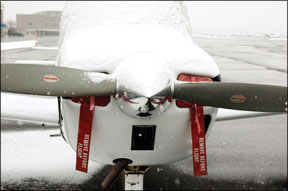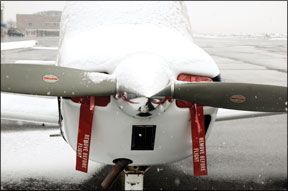Now that winter snows have passed and the foliage is turning green, its time to get out and go flying. If you havent committed aviation since the seasons first snowfall, its going to take some effort to get both you and your craft ready to go. You might presume when pilots go out to resume flying in the spring after a winter hiatus theres an increase of certain kinds of accidents. An examination of the accident records for 1996 and 1997 and again for 2003 just didnt show any patterns. Runway loss of control (RLOC) accidents account for a significant portion of general aviation accidents throughout the year but theres no particular spike during the months many of us are out trying to knock off the rust. If there is an 288 increase of RLOC accidents in the spring, its lost in the noise of the overall increase in flying. The point gleaned from this observation is simple: There is no easy answer about what to study or where to focus a review. Instead, its obvious that a full general review is critical, and no such effort is complete without concentrating on proper takeoff and landing techniques. Heres one way to get you and your plane ready. Plane… Your plane may still be in annual, but if it hasnt flown recently you should get it ready. We like to start by giving it a nice bath. Its amazing all the squawks you can find on your plane when you give it a thorough washing. Its been exposed to some harsh conditions over the winter, even when in a hangar. As you wash it, check the paints condition and look for any peeling or bubbling underneath. That can mean corrosion is lurking and requires a mechanics look-see. Replace any corroded non-structural fasteners with new ones. As you get to the moving parts, pay close attention to seals, o-rings, possible leaks and general lubrication. Rubber may have dried or cracked during the harsh winter conditions. Dont forget the doors/canopies, and even simple things like any latching levers on the door or fuel caps. Clean off the really messy bits with solvent, but of course be careful not to let the solvent get directly into the lubricated parts. None of these are necessarily grounding offenses, but should be put on the list for attention. While youre examining the landing gear, pay particular attention to the tires and the brakes. Remove the wheel pants, if any, for a look inside. Sometimes if you dont fly a lot, tires will deteriorate with age and become unserviceable well before they wear out. Look for small cracks in the tread and sidewalls. Inspect brakes and brake lines carefully. Youll probably find surface rust on the brake rotors, but unless its deep or pitted, this is normal and should grind off during the first few brake applications. Youll likely find a few things for your mechanic to attend to before you go crank up and taxi out. Or, perhaps your annual is due just as the weather begins its siren song, luring you back out to the airport. Washing the plane is an excellent start, but then turn it over to your mechanic and hell be inspecting all those things and much more as part of a good annual inspection. He wont get as dirty, either. …and Pilot We start a pilot refresher with a ground school review. It sounds tedious and basic, but a review of the basics is a good way to get started and usually guides the review into areas where we really need it. Got a pilot buddy, airplane partner or fellow flying club member whos in the same boat? Group learning can be more effective and more fun. Maybe itll be a nice hangar-flying session where you share a few adult beverages. Do whatever it takes to make the process enjoyable, yet keep it focused and productive. If you just need a quick brush-up, this might only take a few hours. If youre really stale you may want to plan for a few sessions spread over a week or two. Need a flight review? Invite an instructor to your final study session and have him lead it so it can be the ground portion of the flight review. Review aerodynamics, weather, regulations, airspace, navigation, systems, performance, maneuvers, emergency procedures, etc. You know: all the basic private pilot stuff. Sometimes just getting out a local chart and your old textbook and flipping through the pages will be all you need. Once youve gotten the ground material mastered again, its time to go flying. Consider doing it first in your arm chair. Remember how you mentally walked through procedures in your arm chair when you were a primary student? Thats an outstanding way to review. Now that youre ready and the plane is ready, its time to check out all the other stuff. Got charts? What year did they expire? Database for the GPS? Youll probably need replacement batteries for everything that takes them, like your portable GPS, handheld radio, headset, flashlight, etc. If the batteries are rechargeable, it might be a good idea to put them on a charger for a few days to help them come out of hibernation. Consider draining and recharging them to make sure theyll still give you proper endurance. Unless, after some careful introspection, you can honestly say you just need to go out alone and do a few bounces, we recommend taking along an instructor when you first get in the plane. You may not feel you need any dual, but its good to have a safety pilot along. After all, youre doing this because youre rusty, right? You know youre going to make mistakes. Who better to have along than that crusty ol CFI whos been teaching people how not to crash airplanes for longer than youve been a pilot? Regardless of whether you are asking for some structured instruction or just having someone along to give you confidence and save your bacon if necessary, take along an instructor. Then, go turn some gasoline into fun. A good guide to what fun to have is the private (or commercial) pilot practical test standards (PTS). Dont be afraid; you can do it. In fact, chances are you can probably do everything better than you expected. Sure, the commercial maneuvers will give you fits since you havent done them in years, but itll be fun to learn to do them all over again. Of course, as indicated by the patterns of general aviation accidents, you should thoroughly review take-off and landing procedures. If theres no wind where youre flying, you should go find some and vigorously exercise your crosswind landing skills. Anyway, go through everything from the PTS systematically and youll be done before you realize it. Weve found that one of the best parts of a flight review like this is that it can truly be a fun experience since there is no pass/fail pressure. Theres just your own satisfaction and peace of mind. Once youve again mastered flight, remember to master your airplane. If all youve got is basic VOR navigation your ground review was probably sufficient. But, if youve got a GPS with all the functions (…and who doesnt?) or one of the current generations of TAA, you definitely want to spend some time reviewing procedures. After a ground review, chances are youll need to do some stuff in the plane, exercising a lot of those functions youve forgotten. Go Somewhere Put all this work to good use and plan a trip. Maybe its just for the $100 hamburger or maybe further, but plan it thoroughly. Check the weather, plan your route complete with visual (not electronic) waypoints, fuel burn, everything. Youll be amazed at what youll remember when you do this, and itll be a good review of all your flight planning tools. Then, execute the plan. Guess what? Youre current! You can go flying any time you want to! Maybe even vow to keep flying this year so you dont have to go through all that review again next year. Frank Bowlin flies CRJs for a large regional airline and is an independent CFI in Watsonville, Calif.




